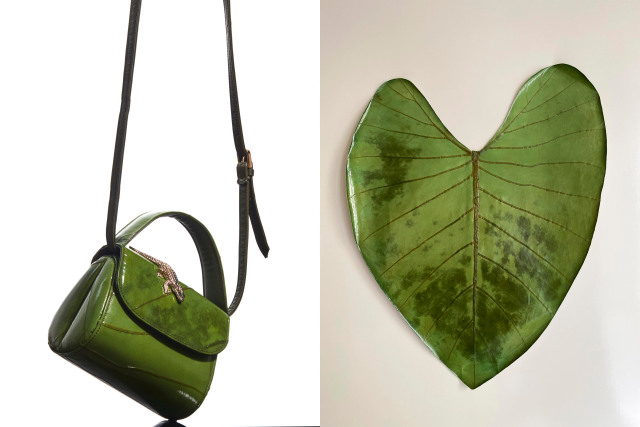Experimental accessories designer Amélie Pichard is launching a new brand subset that focuses on innovative, sustainable materials.
OVNI launched for pre-orders this week with bags made from three leather alternatives — pineapple fiber material, cactus faux leather and the world’s first bag made from Brazilian elephant ear leaf. Each of the vegan materials has been retrofitted to Pichard’s classic “A bag” design — with a signature alligator sitting atop its flap. Pichard said with OVNI she wants to give shoppers — many of whom have intermittently requested vegan materials — a choice of emerging materials.
While a shoe designer first, the Paris-based Pichard wanted to experiment with the materials in small production runs — and so handbags seemed like a better starting point, since they do not require a full range of sizes. Depending on how the materials perform and how consumers respond, Pichard said she will consider expanding into footwear as well. Through trial and error, she hopes for her brand to eventually only use alternative and sustainable materials.
Pichard has worked with recycled materials in the past, including a line of handbags made from deadstock Seventies wallpaper sourced at French flea markets. Over the last 10 years, her brand has shape-shifted with the winds of emerging ideas in fashion. In 2016, she cut out all wholesale operations in order to focus on slow fashion and protect her brand’s longevity. In 2017, she was among the first designers to open a secondhand component of her e-commerce web site.

Related Gallery
A Look Into Marine Serre’s Paris Studio
But now rather than label herself a sustainable designer, Pichard was careful to note that, much like in the world of non-dairy milks, research of renewable materials is still nascent and there are few perfect options.
“Almond milk is a good example of how when everyone wants something, a lot of problems occur for the environment to produce that kind of quantity. My idea is just to explain the good and bad things about each material so people are more aware about their choices and they can then choose what they want. People have to know what they buy — so many brands today just write ‘vegan leather’ and it’s made of plastic,” Pichard said.
The designer has included a full dossier of information about each material on her web site. Piñatex, for example, is made from 90 percent biodegradable material — spun from pineapple plant leaves. The remaining 10 percent is plastic material — a ratio that has improved in the five years since the material first hit the market.
The faux cactus leather she has used is comprised of 50 percent natural material, but its remaining contents have not been disclosed by manufacturers.
“It’s ideal to say vegetable material is ecological but they are still experimental and, to be very honest, vegan and vegetable leathers are not 100 percent made of vegetables – they are always mixed with petrol or plastic, so it’s not totally clean,” Pichard said.
The new leaf material Pichard is now working with is nearly carbon neutral, produced in the Brazilian rainforest by bioleather company Nova Kaeru. Called beLeaf, the material comes from the elephant ear plant, which regenerates its leaves — therefore no plant is killed in the harvesting process. The company works with indigenous people in Brazil to forest leaves and then puts them through an eco-friendly tanning process that stabilizes the leaf’s fibers so they do not rip or react to scratches or contact with water.
“This leaf is unlike other natural materials because it’s just a leaf — there’s no additives. It feels like leather, so we thought a true vegan leather didn’t exist and now it does. You can still see all the detail from the leaf though, so it’s not so futuristic,” Pichard said.
Nova Kaeru said Pichard is the first to use its new material for a handbag. It is working on promoting the material for a variety of uses, and has produced samples with the leaf used in picture frames, upholstery and sneaker applications.
While the material comes in a variety of colors, Pichard settled on a vibrant green for her bag to promote the concept of its leaf origins. The bag was produced by glueing the material to linen, and then stitching the two together — almost as if it were leather.
For Pichard, this is just the starting point for what’s to come. She is waiting on the development of a new material from Denmark comprised entirely of apple pulp, which has been in the works for more than two years.
Despite these new vegetable-based products, Pichard is not abandoning leather altogether. In the next year, the designer plans to introduce a new innovative way for consumers to engage with leather goods. She’s in the process of linking with a network of small cattle farmers across France who raise steer for its meat, and intends to use their hide byproducts to create a new era of transparency in leather goods.
By teaming with farmers, Pichard hopes that her shoppers will soon have access to a fully transparent journey of the leather from which their bags and shoes are made. She wants to offer them the name of the farm where their bag’s leather comes from, the cow’s name, and perhaps even a photo of the animal — bringing consumers closer to the origins of their material belongings.
“It’s something that doesn’t exist yet,” Pichard said. “Nobody can trace leather to a specific farm, they only know where the animal was slaughtered. I want people to know more about where their things come from. My idea is to make my entire brand innovative in that way, to bring a new value to artistry.”
Source: Read Full Article
